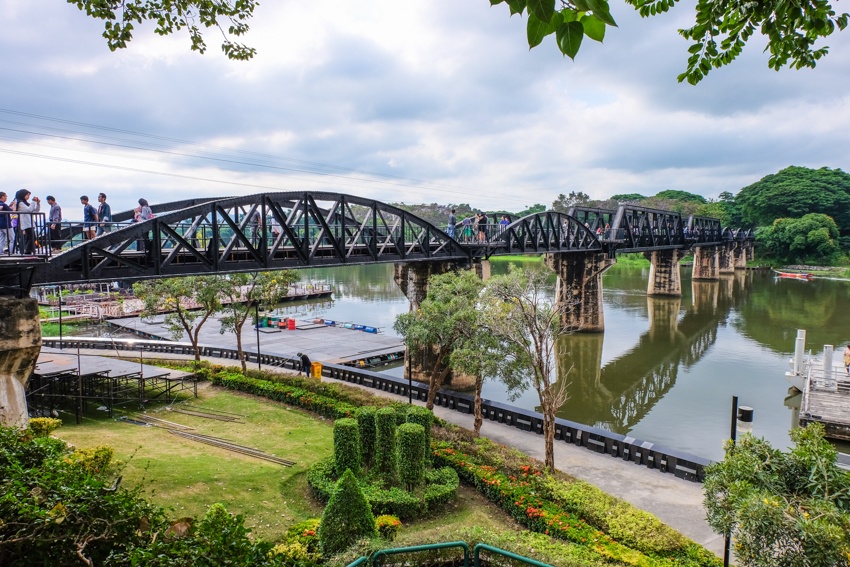
The Bridge Over The River Kwai at Kanchanaburi
After an hour of travelling on the tired looking train, the wooden benches the only form of seating available in 3rd class, the click-clack of the runners colliding with the railway track had become quite therapeutic.
Opposite sat a gentleman that was clearly comfortable propping himself up against the aged wooden window frame, his body gently swaying in time with the sideways rocking motion that had started since picking up speed whilst next to us sat a family of three, the child super excited to be spending the morning aboard a train, jumped up and down at each new thing he glanced at as we sped through the countryside to our next stop-off.

At each new station, locals would board the train, big wicker baskets propped on their hips laden with goodies they hoped to sell. Unlike, when travelling on a train in the UK, there is no reason to go hungry here. Whilst one seasoned trader was trying to convince us to buy a bag of popcorn another came wandering by with something on a stick whilst a third had large bags rammed full of various colourful fruits cut up ready to be munched on. Then, at the next stop it was all change again, and this time you would see baskets of sugary desserts and unusual looking treats spread out on a tray, the owner trying to convince people to ‘give it a go’. It was fascinating to watch; to hear the banter and bartering take place and to see the locals flying on and off the open carriage doorways at each stop along the way.
‘This is Thailand’ was all I could keep thinking to myself: authentic Thailand. Yes, we were on a train heading to possibly the most touristy attraction around Kanchanaburi but at the same time we were surrounded by Thais just going about their everyday life, something we would not have seen had we opted to travel in the so-called style at the front of the train, reserved purely for the tourists.

Buy your tickets at the railway station not the tourist stand
Early, as we stood on the platform at Kanchanaburi, waiting for the now very delayed train to Nam Tok, we were approached by a young school girl confused by our presence. It seems that we had become cause for chatter amongst the youngsters who had convinced themselves that we were stood at the wrong end of the platform. Shyly, the young girl explained to us that we needed to move to the opposite end of the platform in order to catch the train. Perplexed we tried to understand why, after all it was the same train so why was she so insistent that we move. Well, it turns out that, should you wish to travel in style along the famous ‘death railway’ line there is a tourist coach at the front of the train and she believed that was automatically where all Westerns would want to be. Once we confirmed that we had actually purchased tickets to sit in the same carriage as her, although unconvinced she wandered back to her small group where more pointing and shaking of the head took place. Apparently, it is unusual for visitors to travel with locals, instead they normally opt for the inflated tourist price in order to sit in more comfortable surroundings, eat cookies and receive a certificate from the tourism board to say that they had travelled along the famous train line. Not bad I suppose for just 300 baht (£6.80) per person each way when you compare it to the cost of British train travel, but here in Thailand when you can pay 100 Baht (£2.29) for the same trip why pay more?
Plus, I guarantee that we had a far more entertaining ride, even if it did mean that we were frequently starred at, smiled at and greeted by locals asking questions about our trip. Surely, this is the experience people crave for when travelling around a different country.
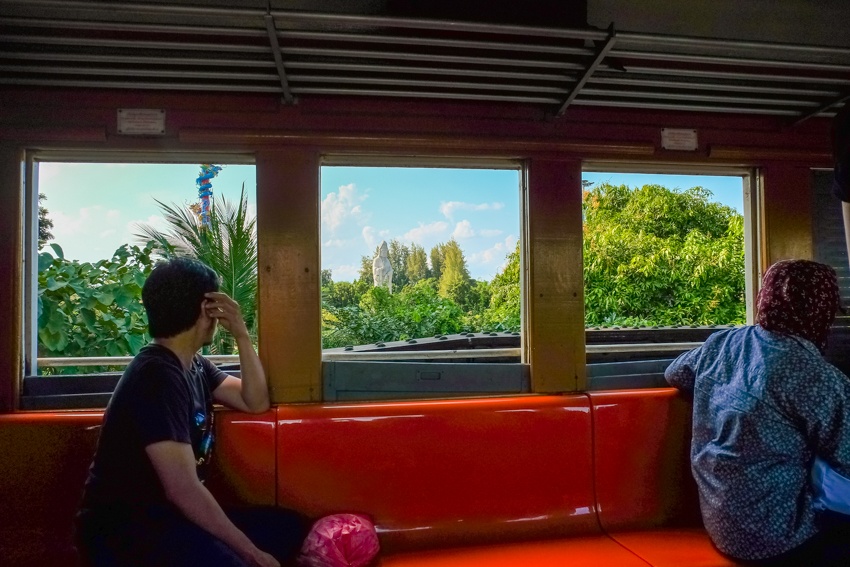
The carriage during our return trip to Kanchanaburi
Why Is The Train Line From Kanchanaburi to Nam Tok So Famous?
Back in September of 1942, construction of this now very famous railway line begun in Burma. The idea was that this would become a supply route for Japanese troops and would connect Burma to Thailand from Rangoon to Bangkok through the Three Pagodas Pass and along the Kwhae River.
With 69 miles to cover on the Burmese side and a further 189 miles on the Thai side, this was a big ask especially when considering the terrain of hilly jungle terrain and numerous riverbeds. However, for the Japanese, who had recently been defeated during the Battle of Midway, using POW’s to construct this now desperately needed line seemed like a small task. After all, when looking at the bigger picture did it really matter if lives were lost?
In just over one year, the once unthinkable had become a reality and the railway line had been completed, but at what cost? Depending on where you look, some believe that potentially 100,000 people lost their lives during the construction of this now defunct line, so you have to question whether all the effort and loss of life was really worth it.
And it wasn’t just the work that was dangerous, the living conditions were atrocious, with many deaths caused through vitamin deficiency, ulcers, dengue fever and cholera often brought on by malnutrition, starvation and the lack of suitable sanitation. Imagine having to spend all day lifting heavy wooden train sleepers on just 250 grams of rice. It therefore should come as no big surprise that they had to bury 20 or more men a day. Hence, the now popular ‘Death Railway’ name tag.
Is It Worth Visiting The Death Railway Line?

The Bridge over the River Kwai in Kanchanaburi
Kanchanaburi has, over the years, become more touristy however, in comparison to other areas in Thailand this is still a relatively unexplored area to visit.
Many of the 5 million tourists that visit each year do so as part of a day trip from the capital, Bangkok and therefore, it remains a peaceful place to stay. That being said, when the train rolls into Saphan Hwae Yai (the River Kwai station), 100’s of people quickly board in the hope of gaining a seat for the near two hour journey to Nam Tok where they will then disembark and head off to Hellfire Pass, a further 18km away.
Hellfire Pass is possibly the best known element of what was at one time part of the Death Railway; however, there is one section of the bridge still standing together that is also well-worth a visit – the Wampo Viaduct.
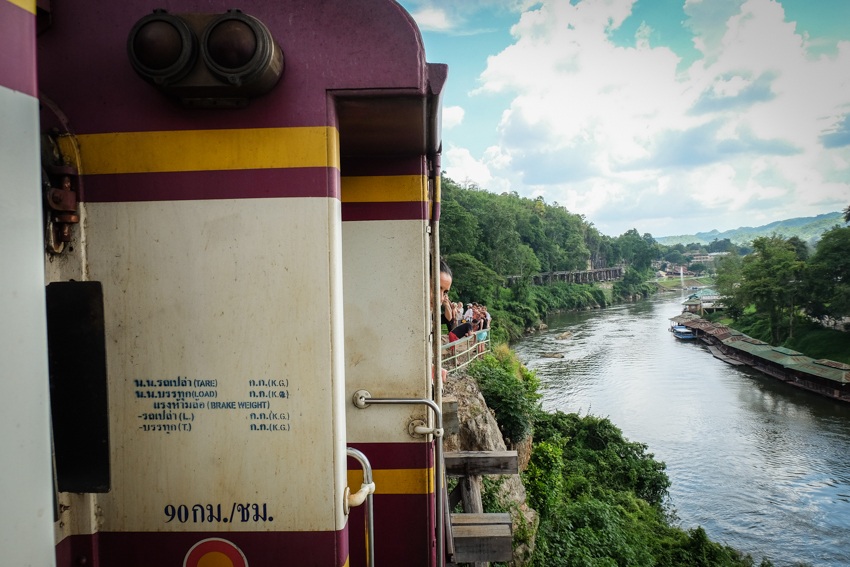
View from the train
What do you mean you have never heard of the Wampo Viaduct? Well, to tell you the truth neither had we, but during our trip it was of those places that completely wowed us.
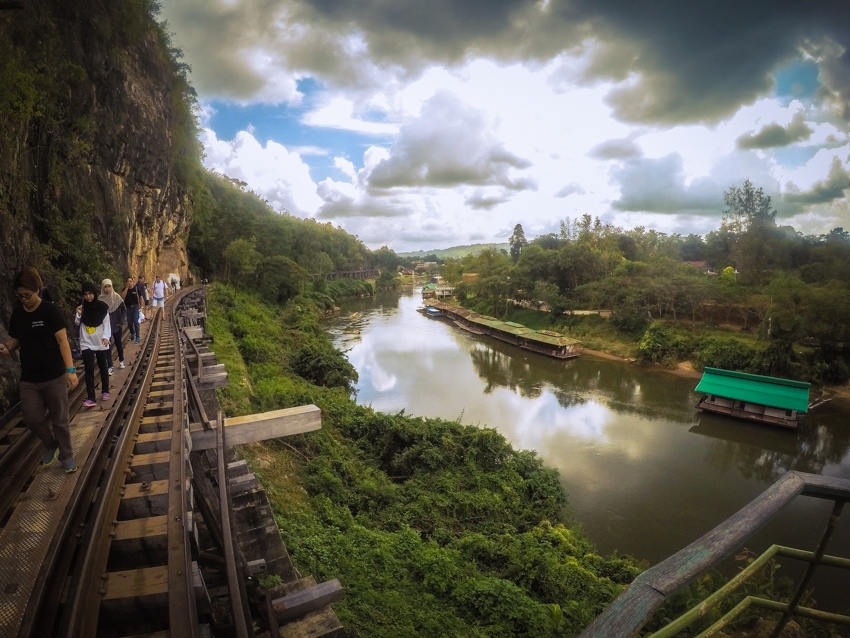
View from Wampo Viaduct
Why Everyone Should Stop Off At The Wampo Viaduct
It is one of those places, that should you decide to take one of the many organised day trips, you will find yourself exploring for an hour or two either on the way or returning from Hellfire Pass, however, in our opinion it is best experienced on the train.
As you approach from Kanchanaburi, the valley begins to open up, the green fields start to slip away and the flat landscape turns into a hilly, riverside paradise. Yes, that’s right – the scenery is absolutely breath-taking and in complete contrast to the image I had in my mind after reading about the conditions in which men would live during the construction of the railway.

The Wampo Viaduct which hugs the cliff face of Kwai Noi is of wooden construction and is the only section built by the POW’s still standing today. Standing at over 8 metres in places, this is one location that will make your jaw-drop as you are crossing, especially if you are standing close to the permanently open carriage doors looking down.

The view down from Wampo Viaduct
As you pull into Sapan Tham Krasae Station this is where a quick decision needs to be made, because the train will slow and appears to stop but only for a brief moment. This is where I start screaming for you to ’GET OFF THE TRAIN’ because it is at Wampo Viaduct that you can experience something very unique. It is at Wampo Viaduct that you will be able to wander along the original wooden trestles and see for yourself exactly high up off the ground those POW’s had to climb in order to build the track.
Don’t do what we nearly did and discuss whether or not to continue on to Nam Tok without stopping here. If you work on initial impressions you will be tempted, but I promise, getting off the train will be worth it.
Yes, there are several little stalls set out along the train line, tempting tourists in with their wares – clothing, souvenirs, ice cream and even a wine shop – but when you look past that, and remember that you are about to step foot on to what is quite possibly the most well-known bridge in the world, how can you not be amazed by your surroundings.
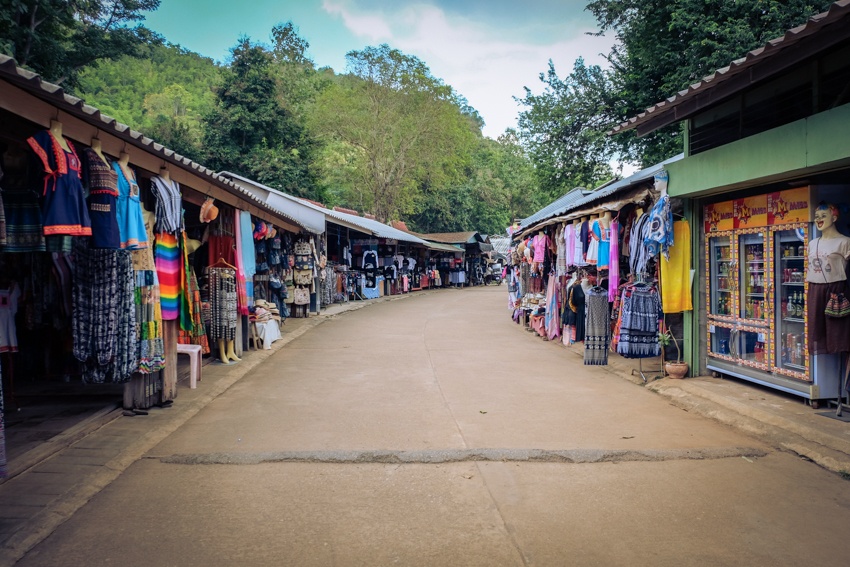
Stalls around Wampo Viaduct
However, this is probably the point where I need to highlight that, if like us, you are not always the earliest to rise, you will need to make a decision – Wampo Viaduct or Hellfire Pass. Why? Well there are just two trains a day that arrive at Sapan Tham Krasae but unless you want to catch a train at 6.15am there isn’t enough time to explore both locations in one day.
Wampo Viaduct, is extraordinary; it is one of those locations that until visiting Kanchanaburi we knew nothing about but were so glad we experienced.
Standing solid above the river bank, Wampo Viaduct, is one of the only wooden structures remaining on the line today and is notable for its grandeur and fear-inducing feelings.

From the edge of Wampo Viaduct
It was one thing to go across on the train but to wander across is possibly even more frightening. With each step you take you can see the ground below showing through the gaps, the metal plates that have been put in place to strengthen the beams doing nothing to stem the growing concern building in my stomach. The planks are obviously not very wide, and for every person walking one way along the track, three seem to be returning which results in large groups of people lingering at pockets along the way. Doesn’t sound that bad? Well when you consider that a railway sleeper is on average just 250mm wide, that doesn’t give you much room to move around.
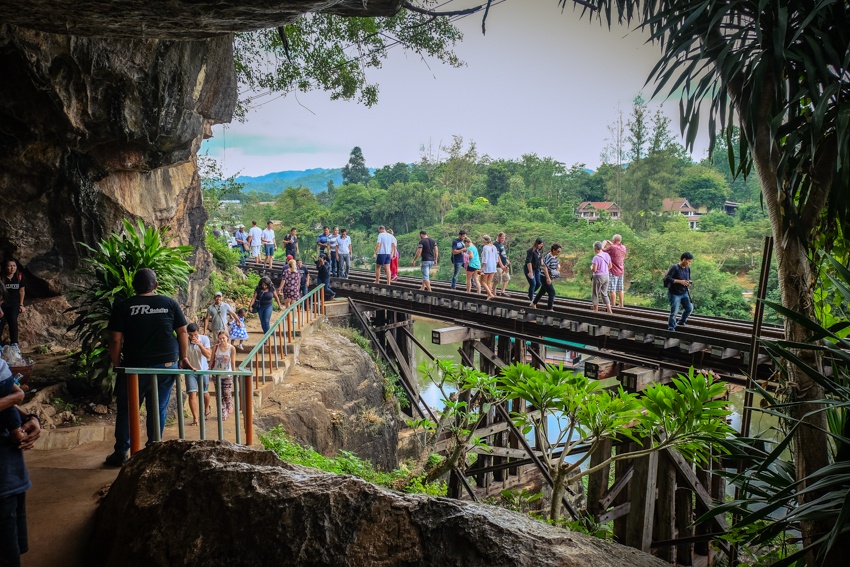
Crossing the Viaduct

On the Wampo Viaduct
However, you forget all of this when you look out over the landscape and see the stunning views for the viewing platform half way across the bridge. For the views alone, it is worth lingering here. Although, if you are like me, it is also a time to reflect and think about all those people that had fought for their country to then go and loss their lives building this immense structure. It is one of those locations that will forever remain bittersweet in people’s memories – a beautiful site created in the most horrific ways and I personally believe that it is for that reason everyone should visit.
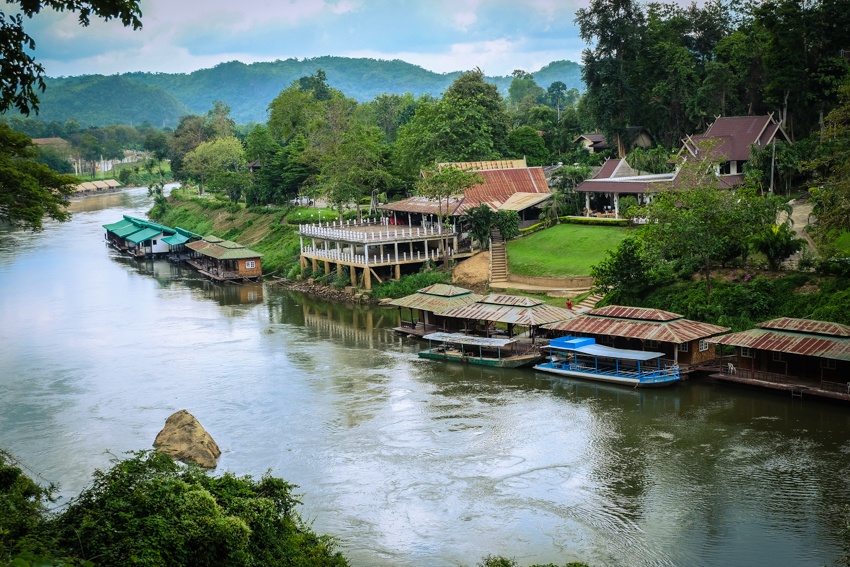
Views from Wampo Viaduct
For that many people to have lose their life creating something, those that remain should remember them.
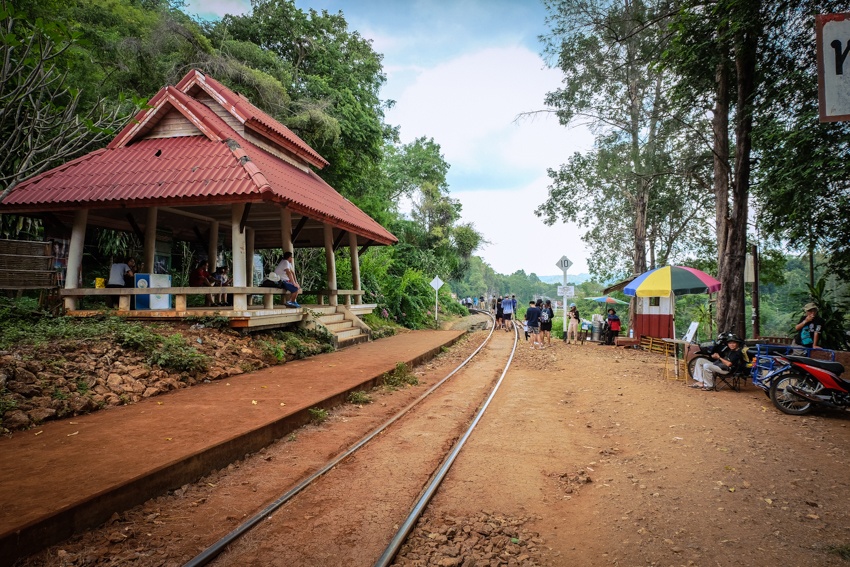
Sapan Tham Krasae Station
Three Other Reasons To Train The Death Railway
#1 When you stop at the Wampo Viaduct there is also a large cave with a very impressive Buddha statue inside, well worth visiting.
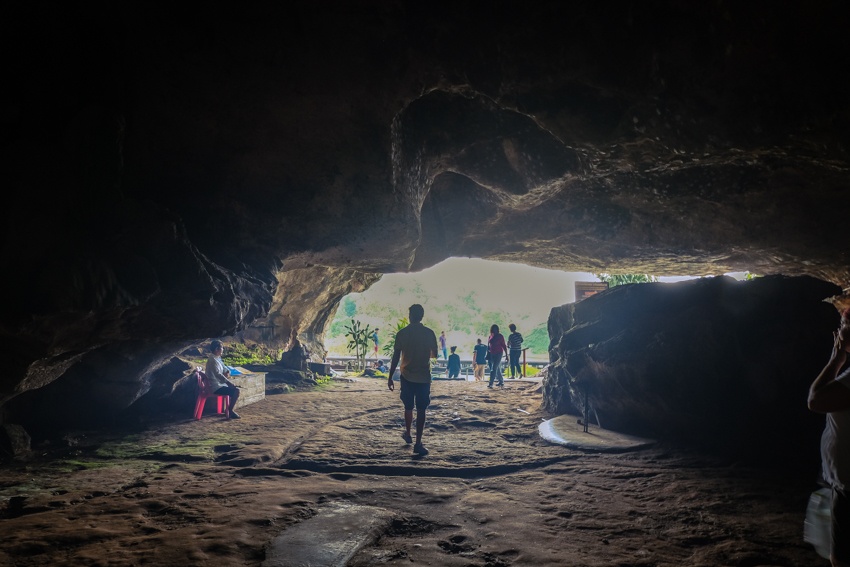
Cave at Wampo Viaduct

Inside the cave
#2 Nam Tok, at the end of the line, is also the gateway to Nam Tok National Park where you will find the spectacular seven tiered Erawan Falls and Sai Yok Yai National Park.
#3 By travelling on the Death Railway line you can also get to Hellfire pass, the location of the original track, although be warned when you get to Nam Tok you will need to either catch a bus or barter with a Tuk-Tuk driver to take you the rest of the way. Once at Hellfire Pass you will be able to wander the area around the original track before exploring the museum to take in the history of the bridge.
The train from Kanchanaburi actually starts at Thonburi in Bangkok and costs just 100 Baht regardless of journey length which means should you wish to can travel from Bangkok to Nam Tok and back again for just 200 Baht on a day trip. However, our advice would be to stay a night or two in Kanchanaburi in order to explore further.

Have you visited the Wampo Viaduct? We would love to read about others that have experienced this area.
If you have enjoyed this article why not pin it for later.


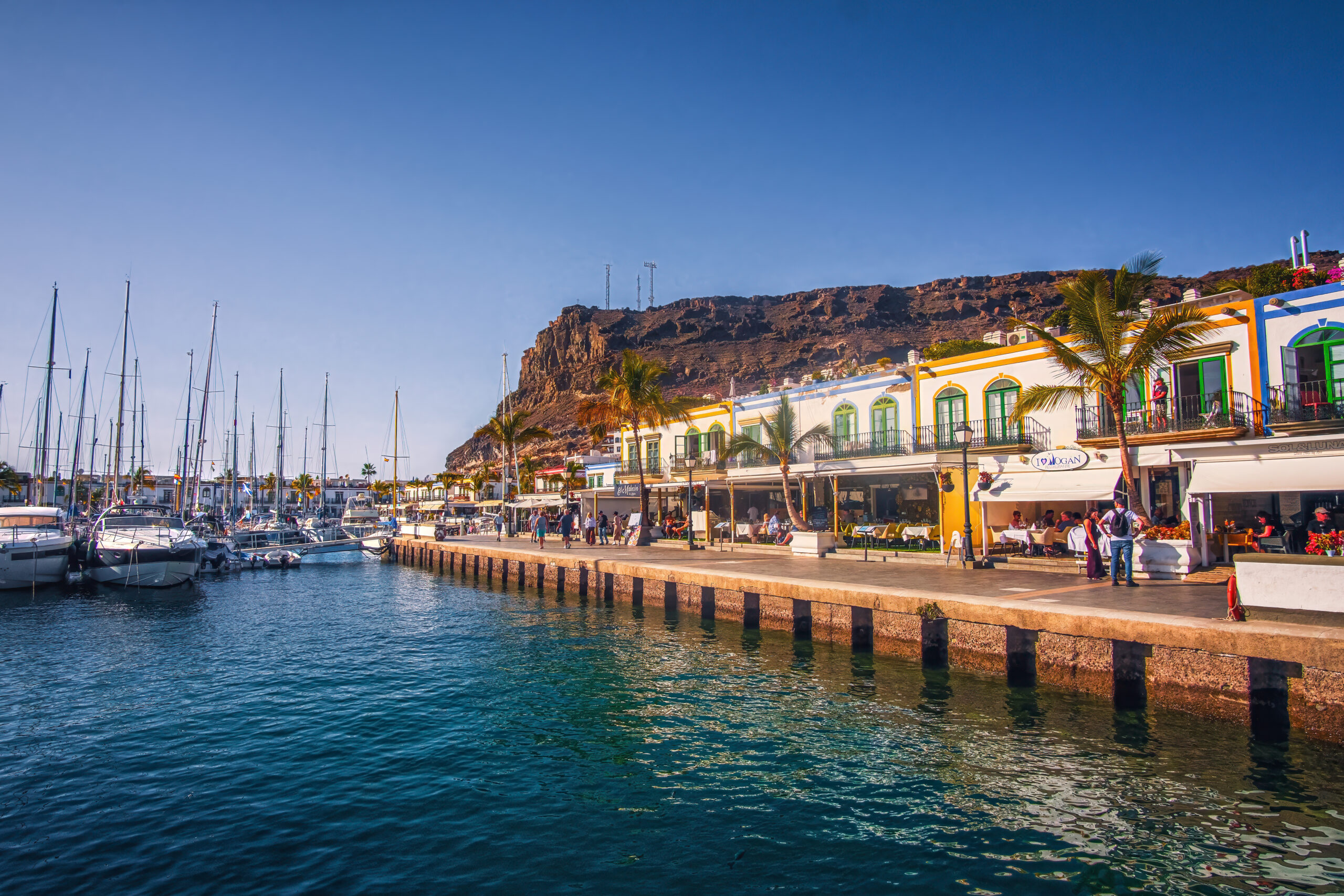

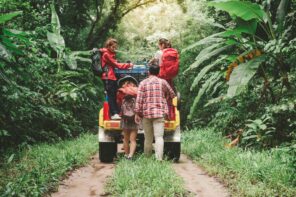

I’m planning a visit to Kanchanaburi in February. I want to visit Hellfire Pass, but not clear on information about rides to Hellfire Pass from Nam Tom. Is this something that has to be arranged ahead of time? I would hate to assume that I can hire a ride and find that I should have already arranged one! After reading your posts about Wampo Viaduct, I will probably plan an extra day in Kanchanaburi. Looks very exciting! Can you please advise me?
Hi Selma, I am quite jealous you are planning a trip. It was one of our favourite parts of our Thailand visit. You can actually get the train from Kanchanaburi to Nam Tok and it stops at Wampo Viaduct as well. When you get to Nam Tok a bus takes you to Hellfire pass, just remember the train timetable and my suggestion would be not to try and do both Hellfire pass and Wampo Viaduct on the same trip as it takes quite a while to reach and you will easily miss the train if you are not careful. You can also take the bus from outside the War Cemetery all the way to Hellfire pass. Neither of these need to be booked in advance, you can just turn up on the day.
We spent three days in Kanchanaburi and could have easily extended further. We missed out on seeing several temples and waterfalls because of our tight timescales and do plan to return one day to see more. We hired a scooter for a few days to get around. The roads were quiet and we never came across any issues but I understand that this comes down to confidence but there are also many drivers that will take you to the locations you wish to visit.
I would also highly recommend On’s restaurant. Not only was it probably the cheapest meal we ate, it was one of the best. http://onsthaiissan.com/
Let me know what other information you need on the area, we are always happy to help.
Hi, first of all – thanks for the very comprehensive write-up on the death railway, it’s exactly what I’m looking for to plan my own trip!
I just need to ask though, what time did you arrive at Wampo Viaduct? And how long did you spend there?
I’m asking because I need to know if I arrive at 5.50pm (the last train), will I still be able to catch a train back to Kanchanaburi town?
We got on a train around 11am and therefore did consider having lunch at the viaduct (there are a couple of places although all very touristy). There are only a few trains a day as it is a single line. I have included a link to a train timetable to and from Wampo viaduct, I hope this helps. Enjoy your stay.
I love the photos, the view captured my heart!
Thank you for your kind comments about our photos.
I have never heard of this before but I love the amount of detail you went into about its rich history. The pictures also show it’s worth a visit! Thanks for sharing
it really is a lovely place to visit if you get the opportunity.
Great post and I swear I could not take my eyes off the pictures! They look fabulous. I haven’t been to this place and now I seriously want to visit.
Thanks for your comment about the photos. It is a beautiful even with its history.
YES! I went there 3 weeks ago and I’m writing a post about kanchanaburi right now
I have to say that Kanchanaburi was my favorite region in all Thailand!
I agree, it really is a stunning part of the country. Did you visit any temples whilst you were there?
That is some amazing view from the train window! Lovely scenery! These one of the scariest places though! because I am afraid of heights. but seems like you had a great fun! Cheers!
I don’t always do that well with heights either but after the initial wobbling legs it wasn’t too bad, although when crossing over a train sleeper and looking down I did have a little panic!
Great post and fascinating story. You described everything so well, and the photos are breathtaking.
Thanks Tami. It is one of those places that completely fascinated me. We would actually return if and when we head back to Thailand we enjoyed it so much!
Stunning photography. You’ve absolutely convinced me that the Wampo Viaduct is not to be missed. Love the post!
Thanks Cez, I think people head to Kanchanaburi and instinctively head straight to Hellfire Pass which of course is historically significant and tend to ignore Wampo Viaduct completely. To wander along a stretch however that is still standing and remember those that suffered because of it is immensely moving.